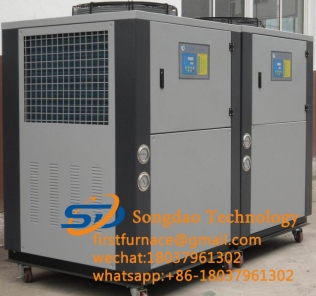Sales hot line ( 24 hours service):+86 13015583380
E-Mail: firstfurnace@gmail.com
whatsapp:+86 13015583380
Adress: Luoxin Industrial Park, Luoyang, HenanLarge diameter steel pipe quen
Piston rod quenching and tempe
Grinding rod quenching and tem
High frequency induction heate
Quenching equipment for machin
Round steel end heating furnac
Steel pipe heat treatment prod
Square steel quenching and tem
Sucker rod quenching and tempe
Thickened petroleum steel pipe
Round steel quenching and temp
Steel pipe quenching and tempe
Steel plate quenching and temp
Induction Hardening Machine&nb
Flywheel ring gear high freque
What constitutes the non-condensable gas in the industrial refrigerator system?
In the condenser of the refrigeration system, some non-condensable gas is often collected. This kind of non-condensable gas appreciates the heat transfer of the induction condenser, increases the condensation pressure and the condensation temperature and pressure, thereby increasing the power consumption of the induction compressor. Air-cooled chiller
The non-condensable gas in the industrial refrigerator system is mainly composed of atmosphere. The atmosphere and other non-condensable gases in the industrial refrigerator make the condensation pressure of the system too high.
The atmosphere comes in the first pass of the freezer system
1. There is a residual atmosphere in the system before the first refrigerant charge
2. When the evaporating pressure is lower than atmospheric pressure, the atmosphere will enter the system through the setting and valve gaskets. 3. When the freezer is opened for maintenance, washing or additional installation, the atmosphere will enter the system
4. When the freezer is supplied with refrigerant and brake oil, the atmosphere will enter the system
5. The decomposition of refrigerant or lubricating oil will produce non-condensable gas.
The way to exhaust the atmosphere and non-condensable gas is
1. Close the discharge valve of the accumulator and then start the compressor. After the refrigerant in the system is discharged into the accumulator, stop the machine. When the compressor is running, pay attention to the pressure gauge at all times to avoid excessive secretion pressure.
2. After the compressor stops, continue to pass cooling water to the condenser and pay attention to the temperature of the inlet and outlet water. After about an hour, when the inlet and outlet water temperatures of the cooling bearing are the same, check the pressure of the condenser and the saturation pressure of the refrigerant used at that temperature (water overflow) (you can find it from the thermodynamic nature table of the refrigerant, Note that the thermal nature table usually provides full pressure values). If it is too high, the slow steamer will open the top of the condenser to release the atmosphere and secrete the atmosphere and non-condensable gas.
3. When discharging the atmosphere, observe the pressure change displayed by the pressure gauge and pay attention to distinguish the breath of the discharged gas, in order to avoid loss of refrigerant. Before opening the atmosphere valve, it is necessary to fully cool the condenser and reduce its pressure as much as possible.
When the atmosphere is mixed in the low-temperature refrigerator system, the atmosphere will accumulate on the heat transfer tube on the refrigerant side. In view of the high thermal resistance of the atmosphere, the condensation area is not enough, and the condensation pressure of the condensation temperature of the refrigerant increases.

Iron induction furnace

Aluminum melting furnace

Copper melting furnace

Small steel melting furnace

Small induction melting furnace

Induction iron furnace

3T intermediate frequency iron melting f

0.25T Intermediate Frequency Furnace

0.5T Intermediate Frequency Furnace

Medium Frequency Furnace

2T Induction Melting Furnace

1T Induction Melting Furnace

500kg Induction Melting Furnace

250kg Induction Melting Furnace

Induction Melting Furnace

3 T Induction Melting Furnace

5T Induction Melting Furnace

1T One Belt Two Intermediate Frequency F

5T One Belt Two Intermediate Frequency F

3T One Belt Two Intermediate Frequency F

2T One Belt Two Intermediate Frequency F

5T Parallel Intermediate Frequency Furna

5T Intermediate Frequency Furnace

5T Series Intermediate Frequency Furnace

3T Series Intermediate Frequency Furnace

2T Series Intermediate Frequency Furnace

1T Series Intermediate Frequency Furnace

0.5T Series Intermediate Frequency Furna

0.25T Series Intermediate Frequency Furn

1T Parallel Intermediate Frequency Furna

2T Parallel Intermediate Frequency Furna

0.5T Parallel Intermediate Frequency Fur







